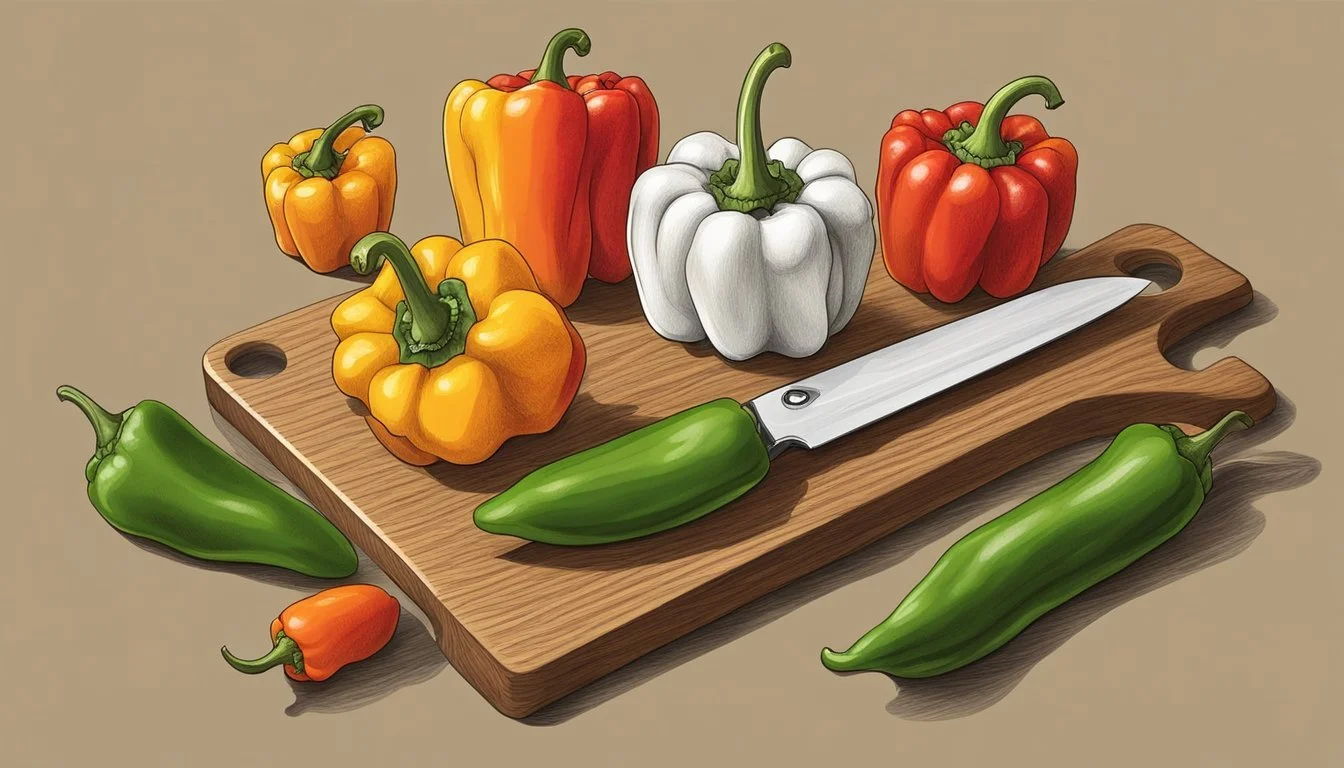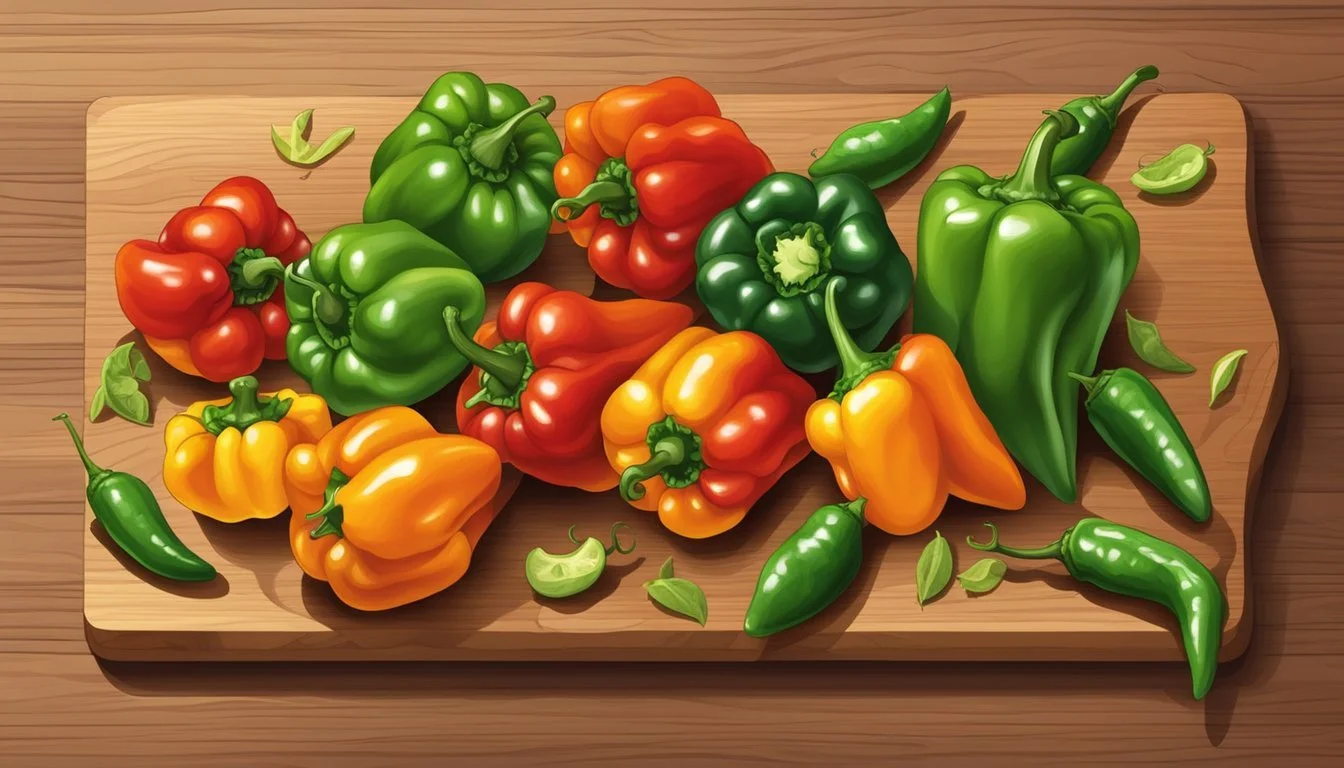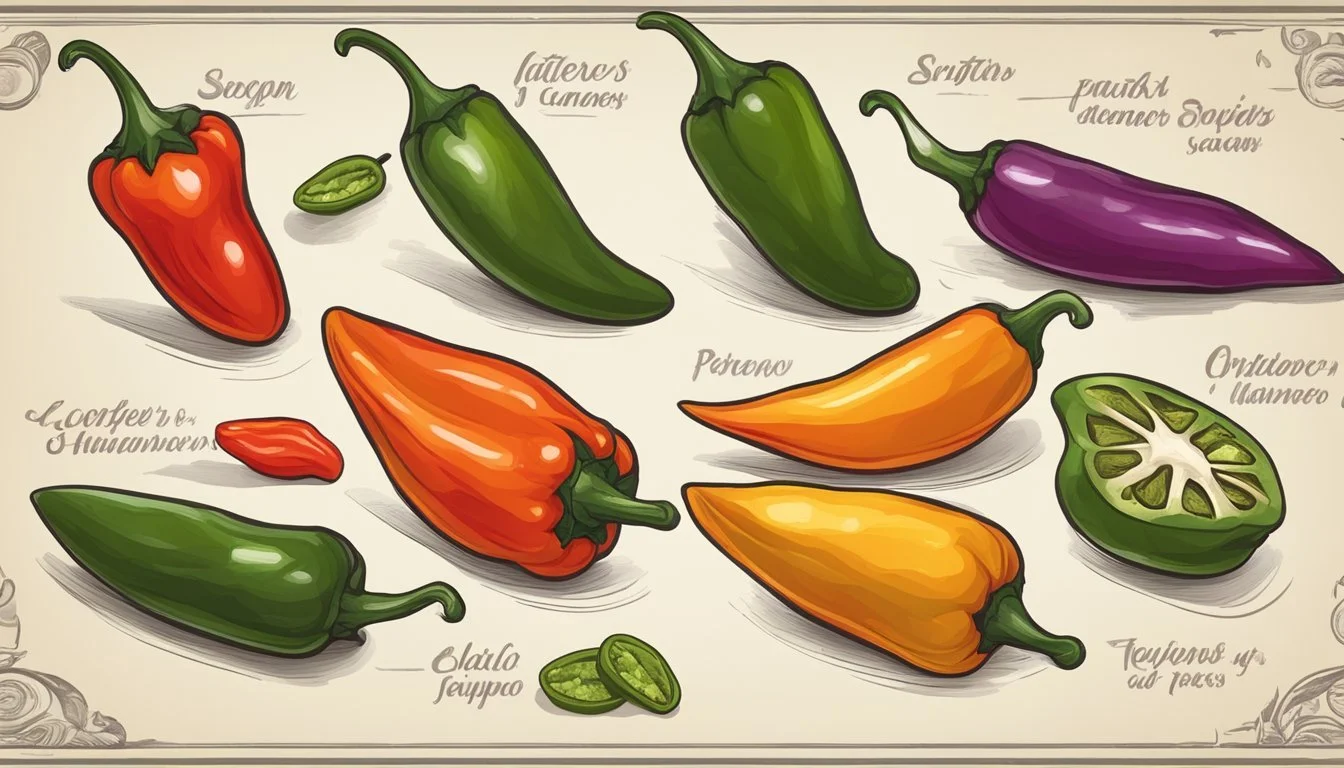Scotch Bonnet Peppers Substitutes
Best Alternatives for Heat and Flavor
Scotch Bonnet Peppers are famous for their intense heat and fruity flavor, making them a staple in many Caribbean dishes. Yet, there are times when finding these fiery peppers proves difficult, prompting a search for viable substitutes. Habanero peppers are often considered the closest match, sharing similar heat levels and fruity undertones. They can be used interchangeably with Scotch Bonnets in most recipes.
Other alternatives include Thai red chili paste, which offers a different kind of spiciness and a blend of Thai spices. For those who need a scorching punch, ghost peppers can also serve as a substitute, though it's crucial to use less due to their higher heat level. Habaneros are not just about heat; they are also valued for their high vitamin C content, adding a nutritional boost to your meals.
Serrano chiles present another option, though they come with a milder heat compared to Scotch Bonnet Peppers. This makes them suitable for those who prefer a more subdued spiciness. The versatility of these substitutes allows chefs and home cooks to maintain the integrity of their dishes while accommodating the unavailability of Scotch Bonnets.
Understanding Scotch Bonnet Peppers
Scotch Bonnet peppers are known for their intense heat and unique flavor, making them a staple in Caribbean cuisine. Their characteristics, Scoville scale rating, and distinct flavor profile contribute to their popularity.
Characteristics of Scotch Bonnet Peppers
Scotch Bonnet peppers are small, globe-shaped chili peppers found primarily in the Caribbean. They typically measure 1 to 2.5 inches in length and display vibrant colors ranging from green to bright red, and sometimes even yellow.
These peppers have thin, waxy skin and a slightly wrinkled appearance. Their unique shape, similar to a Scottish tam o' shanter hat, sets them apart from other chili peppers.
Scotch Bonnet peppers are cultivated in tropical climates and require long, warm growing seasons.
Scoville Scale and Heat Level
Scotch Bonnet peppers rank high on the Scoville Scale, which measures the spiciness of chili peppers. They typically range between 100,000 to 350,000 Scoville Heat Units (SHU).
This heat level places them in the same category as habanero peppers, making them significantly hotter than jalapeños and serranos.
Handling Scotch Bonnet peppers requires caution, as their high capsaicin content can cause irritation to the skin and eyes.
Flavor Profile
The flavor of Scotch Bonnet peppers is as distinctive as their heat. They offer a fruity and slightly sweet taste with hints of apple and cherry, despite their fiery nature.
This unique flavor profile adds depth to dishes and is a key ingredient in Caribbean cuisine, especially in jerk sauces, marinades, and pepper sauces.
Balancing the intense heat with their complex flavor makes Scotch Bonnet peppers a versatile and cherished component in many recipes.
Popular Substitutes for Scotch Bonnet Peppers
When searching for a substitute for Scotch Bonnet peppers, some options are commonly recommended for their heat, flavor, and accessibility. Below are four popular choices that can serve as alternatives.
Habanero Peppers
Habanero peppers are often considered the closest in terms of heat and flavor to Scotch Bonnet peppers. They have a Scoville Heat Unit (SHU) range of 100,000 to 350,000, which is similar to Scotch Bonnets. These peppers are known for their fruity undertones, which makes them an excellent substitute in recipes requiring both heat and a touch of sweetness.
Habaneros can be used in sauces, salsas, and marinades. Their bright orange color and similar size to Scotch Bonnets make them easily identifiable in stores. When substituting, it's important to use the same amount as you would Scotch Bonnets to maintain the dish’s intended heat level.
Jalapeño Peppers
Jalapeño peppers are a much milder substitute. They measure between 2,500 and 8,000 SHU. While they lack the intense heat of Scotch Bonnet peppers, they can still add a kick to dishes. Jalapeños are widely available, making them a convenient choice for those looking for a milder spice.
These peppers have a bright green color and a fresh, slightly grassy flavor. To match the heat more closely, you may need to use a larger quantity of jalapeños or complement them with other spicy ingredients. Jalapeños are versatile and can be used in a variety of dishes, including salads, salsas, and stuffed pepper recipes.
Cayenne Peppers
Cayenne peppers range from 30,000 to 50,000 SHU and offer a good balance of heat without being overwhelmingly hot. Known for their bright red color, cayenne peppers are often used in dried or powdered form, making them a convenient spice rack staple.
These peppers have a somewhat neutral flavor, which allows them to blend well into various savory dishes without overpowering other ingredients. They are great for soups, stews, and even sprinkled over pizzas. When using cayenne as a substitute, it's effective to start with a small amount and adjust to taste since their heat can build up.
Thai Bird’s Eye Chilies
Thai Bird’s Eye Chilies pack an intense heat level, ranging from 50,000 to 100,000 SHU. These small, slender chilies are potent and often used in Southeast Asian cuisine. They make a suitable alternative for Scotch Bonnet peppers when a significant spice kick is desired.
In addition to heat, Thai Bird’s Eye Chilies contribute a slightly floral note to dishes. Their small size can be deceptive, so it’s crucial to handle these chilies with care. They can be used fresh or dried, in dishes like curries, stir-fries, and dipping sauces. When substituting, start with a smaller quantity to avoid overpowering the dish.
Alternative Heat Sources and Flavor Enhancers
For those looking to substitute Scotch bonnet peppers in their culinary creations, there are several options available that match the heat and enhance the flavor of dishes. Among these, hot sauces and chili pastes, as well as dried and ground peppers, stand out.
Hot Sauce and Chili Paste Options
Hot sauces and chili pastes provide a convenient alternative to fresh peppers. Sriracha is an excellent choice, known for its rich, garlicky flavor and moderate heat, making it versatile for various dishes. Tabasco sauce offers a more intense heat with a tangy vinegar base, suitable for those seeking a sharp and spicy kick.
Thai Red Chili Paste combines red chilies with Thai spices, offering a fragrant and fiery option that works well in stir-fries, soups, and marinades. These sauces are easy to find and can be adjusted to taste, ensuring the right amount of heat and flavor for any recipe.
Dried and Ground Pepper Options
Dried and ground peppers are another effective way to replicate the heat and flavor profile of Scotch bonnet peppers. Red Cayenne Pepper Powder is a popular choice due to its consistent heat and availability. It blends well into different dishes, providing a steady level of spiciness.
Paprika, particularly the hot or smoked varieties, can add depth and a slight heat to dishes. Chili powder is also widely used, combining various dried chilies to offer a unique flavor and moderate heat level. These ground pepper options offer flexibility in culinary applications, from stews to seasoning blends.
By choosing the right hot sauce or ground pepper, cooks can maintain the heat and enhance the flavors of their dishes without the distinct presence of Scotch bonnet peppers.
Mild Substitutes for Lower Heat Preferences
For those who prefer a milder alternative to Scotch bonnet peppers, several options retain a good balance of flavor without the intense heat. Two of the best substitutes are bell peppers and Anaheim or poblano peppers.
Bell Peppers
Bell peppers are an excellent mild substitute for those who want to avoid the heat of Scotch bonnet peppers. They have a sweet, fruity flavor and come in various colors such as red, yellow, green, and orange, each offering a slightly different taste profile.
They are commonly used in Caribbean dishes to mimic the fruity and tangy flavor of Scotch bonnet without adding any heat. Bell peppers also contribute a vibrant color to dishes, making them visually appealing. Because they lack spiciness, bell peppers can be incorporated into a broader range of recipes, including salads, stews, and stir-fries.
Their versatility extends to being stuffed or grilled, enhancing the natural sweetness and adding a smoky flavor when cooked properly.
Anaheim and Poblano Peppers
Anaheim and poblano peppers are ideal for a subtler spice level. Both varieties have a mild heat, typically between 500–2,500 Scoville Heat Units (SHU), making them much less spicy than Scotch bonnet peppers.
Anaheim peppers offer a mild, slightly sweet flavor and are often used in roasted dishes or stuffed for a tasty treat. They are particularly popular in Mexican and Southwestern cuisines but can easily fit into Caribbean recipes that call for less heat.
Poblano peppers feature an earthy, rich taste with a hint of sweetness. They can be roasted to enhance their smokey flavor, which adds depth to dishes. Poblanos are a staple in dishes like chiles rellenos and can substitute for Scotch bonnet peppers in salsas, soups, and even some stews while maintaining a lower heat profile.
Regional Alternatives by Cuisine
Different regions offer unique substitutes for Scotch bonnet peppers, each lending a distinct flavor and heat profile to various dishes. The following sections explore suitable alternatives in Caribbean, Mexican, and Asian cuisines.
Caribbean
In Caribbean cuisine, a common substitute for Scotch bonnet peppers is Madame Jeanette Peppers. Known for their fruity, tangy flavor and high heat level (125,000 - 325,000 SHU), these peppers enhance sauces and marinades. Another option is Piri Piri Peppers. While slightly milder, they provide a similar fruity flavor and are suitable for making hot sauces and seasoning meats commonly found in Caribbean dishes.
Mexican Cuisine
Chipotle Peppers offer a smoky, medium-heat alternative for Mexican dishes requiring Scotch bonnets. Popular in salsas and stews, they provide a depth of flavor with their rich, earthy taste. Guajillo Peppers are another excellent substitute, known for their mild to moderate heat and sweet, tangy flavor. Often used in sauces and moles, they enhance the overall taste profile without overwhelming the dish with excessive heat.
Asian Options
For Asian cuisines, Thai Chili Peppers are a versatile substitute. These small, potent peppers deliver a sharp heat and are often used in stir-fries, soups, and curries. Thai Red Chili Paste is another alternative; it combines red chilies with various spices, creating a fragrant and spicy base suitable for numerous Asian dishes. Both options contribute to the complex flavors characteristic of Asian culinary traditions.
Selecting the Right Substitute
When choosing a substitute for Scotch bonnet peppers, two primary considerations are crucial: heat intensity and flavor compatibility. Ensuring these elements align with your dish will help maintain the integrity of Caribbean cooking.
Considering Heat Intensity
Scotch bonnet peppers are known for their high heat levels, typically ranging between 100,000-350,000 Scoville Heat Units (SHU). Choosing a substitute with a compatible heat intensity is essential.
Habanero peppers, for example, offer a similar heat range between 100,000-350,000 SHU. This makes them an ideal replacement for maintaining the dish's spiciness. Ghost peppers provide an even higher heat level, exceeding 1,000,000 SHU, and should be used sparingly.
For those seeking a milder option, Serrano chiles (5,000-25,000 SHU) can be used but will require adjustments in quantity to match the desired heat.
Flavor Compatibility
Beyond heat, it's important to match the flavor profile of Scotch bonnet peppers, which possess a distinctive fruity tang.
Madame Jeanette peppers are a fitting substitute due to their fruity and tangy flavor, commonly found in Caribbean cooking. Thai red chili paste can also serve as an alternative, providing a blend of spicy and aromatic flavors suitable for stir-fries and soups.
Accessibility plays a role in substitution. Ingredients like Thai chilies offer moderate heat and a versatile flavor, often readily available in markets, making them a practical substitute.
Selecting the correct replacement involves not just matching the spice level but also ensuring the fruity and tangy flavor remains true to the recipe. This balance guarantees the dish retains its authentic essence.





